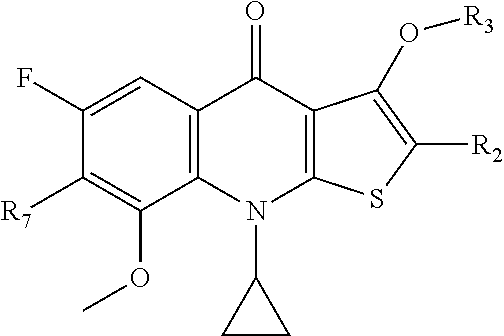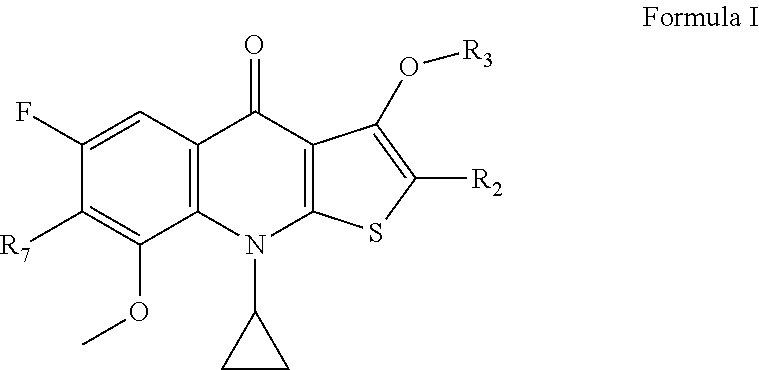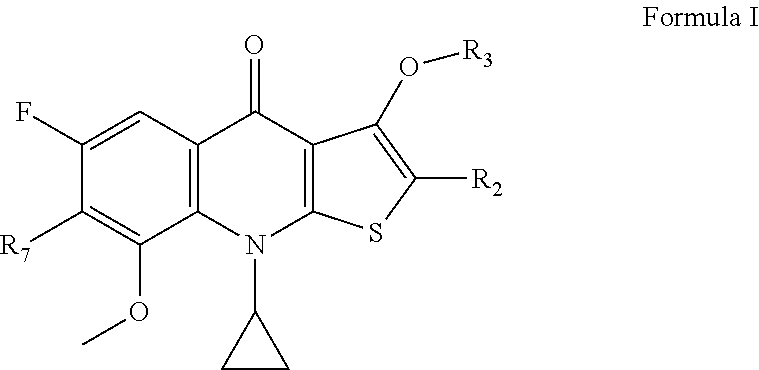2-substituted-thienoquinolones and related compounds as Anti-infective agents
a technology of thienoquinolones and related compounds, which is applied in the direction of antibacterial agents, biocide, heterocyclic compound active ingredients, etc., can solve the problems of increasing morbidity and mortality, increasing the risk of infection with these pathogens in the elderly and immunocompromised patients, and few truly clinically acceptable antimicrobials produced, etc., to achieve antibacterial, antiprotozoal, or selective
- Summary
- Abstract
- Description
- Claims
- Application Information
AI Technical Summary
Benefits of technology
Problems solved by technology
Method used
Image
Examples
example 2
Synthesis of (S)-2-Acetyl-7-(3-Aminopyrrolidin-1-Yl)-9-Cyclopropyl-6-Fluoro-3-Hydroxy-8-Methoxythieno[2,3-B]Quinolin-4(9H)-One
[0123]
[0124]Step 1. Synthesis of (S)-ethyl 7-(3-((tert-butoxycarbonyl)amino)pyrrolidin-1-yl)-1-cyclopropyl-6-fluoro-8-methoxy-2-(methylsulfonyl)-4-oxo-1,4-dihydroquinoline-3-carboxylate (Compound 2)
[0125]The diamine (2.3 g, 1.5 equiv) is dissolved in N,N-dimethylacetamide (35 mL) and the solution is degassed with argon for 5 min. Then sulfone (ref. Org. Proc. Res. Dev. 2007, 11, 389-398) (3.36 g, 1 equiv) and diisopropylethylamine (7.3 mL, 5 equiv) is added and the resulting solution again degassed with argon for 5 minutes. This reaction mixture is then heated at 70° C. for 18 h under argon. The reaction mixture is dropped slowly into cold 1N HCl / 10% NaCl sol. The precipitate is collected and dissolved in CH2Cl2. Organic layer is separated and dried over Na2SO4 and evap. 2.93 g of 2 as an orange yellow solid is obtained.
Step 2. Synthesis of (S)-tert-Butyl (1-...
example 3
Synthesis and Testing of Additional Compounds
[0129]The preparation of compounds listed in Table I can be carried out under conditions analogous to those described in the examples above. Those of skill in the art will recognize routine changes in reaction conditions and starting materials needed to produce the listed compounds. For example, compound 5 in Table I, is prepared by the method shown above, except tert-butyl (1-(pyrrolidin-3-yl)ethyl)carbamate, prepared by the method shown in Schoeder, et al., J. Heterocyclic Chem., 29: 1481-1498 (1992), is used as the amine starting material. Compound activity was evaluated in a standard minimal inhibitory concentration assay such as the assay provided in Example 4. Compound cytotoxicity is determined using a standard assay of cytotoxicity such as the assay provided in Example 5. Compounds 10, 14, and 20 of Table I are provided as comparative examples.
HPLCCyto-CmptRtoxicity#StructureName / NMR Data(min)MSSAMRSAHep2 57-(3-(aminomethyl)piperi...
PUM
| Property | Measurement | Unit |
|---|---|---|
| concentrations | aaaaa | aaaaa |
| volume | aaaaa | aaaaa |
| cell wall permeability | aaaaa | aaaaa |
Abstract
Description
Claims
Application Information
 Login to View More
Login to View More - R&D
- Intellectual Property
- Life Sciences
- Materials
- Tech Scout
- Unparalleled Data Quality
- Higher Quality Content
- 60% Fewer Hallucinations
Browse by: Latest US Patents, China's latest patents, Technical Efficacy Thesaurus, Application Domain, Technology Topic, Popular Technical Reports.
© 2025 PatSnap. All rights reserved.Legal|Privacy policy|Modern Slavery Act Transparency Statement|Sitemap|About US| Contact US: help@patsnap.com



